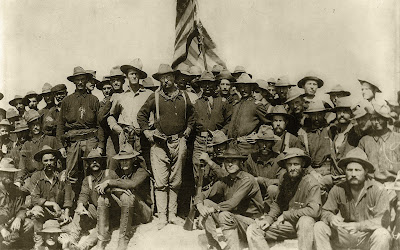Battle of San Juan Hill 1898: Roosevelt and his Rough Riders
On this day in 1898, the 1st Volunteer cavalry known popularly as the Rough Riders, under the command of the future 26th President of the United States, Theodore Roosevelt (b.1858-1919), made their famous assault on the Spanish positions at San Juan Hill in Cuba during the Spanish-American War of April-December 1898. Roosevelt's Rough Riders won national and international recognition for their part in the greater American victory in the Spanish-American conflict fought in Cuba, Puerto Rico, the Philippines, and Guam.
Roosevelt in his Brooke's Brothers tailored uniform, 1898
The Spanish-American War began in 1898 after the mysterious explosion of the USS Maine in Havana harbor. At first the war was Naval clash of arms, between the rising United States of America, fighting together as a whole nation once again, and a declining empire, Spain, who as a result of the war would loose all over their overseas possessions except for Morocco. After the US congress passed the Volunteer Army Act of April 1898, the 1st United States Volunteer Cavalry Regiment, known commonly as the Rough Riders, came into existence with their headquarters and training grounds in San Antonio, Texas . In May, Assistant Secretary to the Navy, Theodore Roosevelt, resigned his position to join the Rough Riders as an officer. In June, Roosevelt and his new regiment left Tampa , Florida for Cuba and war with the Spanish Empire.
At the Battle of San Juan Hill Lieutenant Colonel Roosevelt and the Rough Riders along with elements of a
L-R, Leonard Wood, later a World War I General and Governor General of the Philippines 1921-1927, and Roosevelt in Cuba. The short much older man with the beard is General Joseph Wheeler (b.1836-1906), a former Confederate General who had command in Cuba and later the Philippines.
Battle of Two Hills
Battle of Two Hills
It is often not remembered that Rough Riders were not alone in their charge up San Juan Hill nor did they charge on horseback (the horses were left in Florida) all of the troopers including Roosevelt, who rode a mule earlier in the day before dismounting, made the charge on foot. It is usually forgotten or misinterpreted rather, that the Battle of San Juan Hill was in fact a battle of two hills. The battle was fought first for Kettle Hill, a foothold from which and the famous charge on the Spanish trenches atop San Juan Hill was made near what is today Santiago , Cuba
Both assaults and battles for the heights ofSan Juan Hill were bloody affairs with many American troopers falling to Spanish rifle before they themselves could return fire. It was a brutally hot day as well and several men became casualties from the unrelenting heat and humidity common in Cuba in July.
Both assaults and battles for the heights of
Roosevelt led from the front as he and his men captured Kettle Hill in brutal struggle marked with bloody hand to hand combat and deadly small arms fire. After taking the Spanish entrenchments Roosevelt took it upon himself, since no order was being relayed, to continue the advance. His men were becoming casualties from the bullets fired by the Spaniards German-made Mauser rifles.
An accurate depiction of the battle for Kettle Hill, from Osprey Publishing's Roosevelt's Rough Riders (Warrior #138, de Quesda, and S.Walsh, Illustrator)
After taking the San Juan Heights, the war in Cuba was all but over. By mid July the Spanish had surrendered in Cuba and the War was all but won. In August, the Rough Riders sailed back to America landing in
The United States thereafter became embroiled in not just Cuba but in Puerto Rico, Guam, and the Philippines where the military became involved in first the Philippine Revolution, then two Philippine wars, the first from 1899-1902 established a Filipino free state (a colony) within the control of the United States government and military which ended in 1946 following the Treaty of Manila. The second war took place from 1899-1914 as part of the Moro (Muslim Filipino) rebellion and insurgency. One direct and also indirect consequence of America’s victory over Spain which was partly decided by Roosevelt’s Rough Riders at San Juan Hill was that the American military, primarily the Navy and Marine Corps, would now become permanently stationed as “police and anti-bandit forces" in many regions of Latin America and Central America from 1898 into the mid 1930’s. This series of conflicts came to be known as the Banana Wars; with notable counter insurgency campaigns fought in the Caribbean, the Philippines, and in Cuba, Haiti, Honduras, Mexico, and Nicaragua.








Comments
Post a Comment